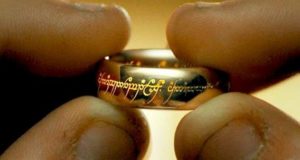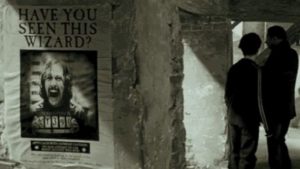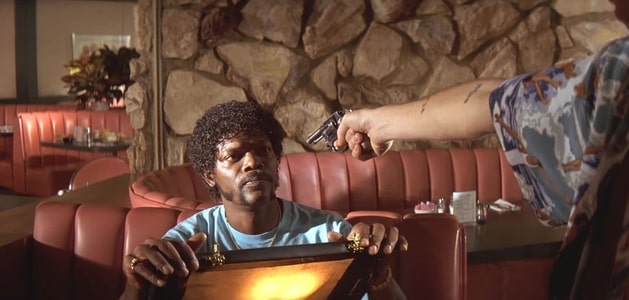16 Powerful Plot Devices To Use in Your Screenplay
It’s a term that gets thrown around a lot but what exactly is a plot device?
A plot device is any technique in a narrative used to move the plot forward.
Plot devices are basically the methods you use throughout your screenplay to tell the story and specifically, get across the plot.
It’s perhaps because plot devices are so explicit in their intention that often they seem jarring to audiences.
Plot devices need to be heavily justified and worked in subtly to the screenwriting. Otherwise, the audience will feel the story being told to them.
Plot devices needn’t be inherently clunky as often perceived. They can help add dynamism and flair to your script. They also keep the audience engaged in your plot.
So what kind of plot devices are we talking about?
We’re going to take a look at some of the best plot devices to use. We’ve thrown in some examples too.
Plot Device #1 – Voiceover and Narration

Voiceover/Narration can be a tempting plot device to use. It provides the audience with the protagonist‘s voice and gives the facts of the action unfolding.
Unnecessary Voiceover/Narration, however, can stick out like a sore thumb. This speaks to how important it is for the Voiceover/Narration to have a distinct purpose.
It can’t just serve as a placeholder for getting across the plot in other, more naturally dramatic ways.
- How does the Voicover/Narration work in tandem or in contrast to the action we are seeing?
- What is the Voiceover/Narration telling us that couldn’t be told in more dynamic, dramatic ways?
- Does the Voicover/Narration tell us something about the protagonist/narrator?
- What is the logic of the Voicover/Narration? E.g. Is it a diary entry? An autobiography? Are the audience a surrogate?
Some Examples of Great Narration:
- Taxi Driver – Travis Bickle writes in his diary. The narration doesn’t narrate the plot but Travis’s thoughts. These are key to understanding why he does what he does in the final act.
- Ferris Beuller’s Day Off – Primarily for comedic purposes, Ferris’s narration is crucial in getting across his charm and likability.
Plot Device #2 – Flashbacks
Flashbacks can be key plot devices in getting across context about the plot, characters or setting. They can be an integral part of the structure. Or they can feature intermittently to provide exposition.
Flashbacks are at their best when they have a consistency and logic throughout.
- A one off flashback can often come across as disorienting.
- Make sure that your flashbacks are a part of telling the story, rather than just a one off solution to getting across a key piece of information.
Some Examples of great uses of Flashback:
- The Godfather Part II – The script gives context to the Corleone family. It tells the story of the family’s patriarch building the crime family that in the present day seems to be crumbling.
- Eternal Sunshine of the Spotless Mind – An ingenious use of flashbacks to tell the story of a relationship. A complicated procedure to find and remove memories means that illuminating flashbacks are a key part of how the story is told.
Plot Device #3 – Montages
A commonly seen plot device particularly in comedies, romances and sports dramas. A good montage will efficiently cover a period of time that it’s not possible or necessary to cover in real time.
Look out for the common traps of montages, however. These tend to be:
- A reliance on cliches. For example, a montage of a blossoming romance that features activities familiar within the genre (synonymous with a cheesiness).
- An unconvincing, unrealistic passage of time or achievement reached. For example, an amateur sportsman becoming a pro in a matter of no time, with struggles easily overcome.
A good montage might also have an editorial tone or voice that operates in contrast to the action. For example, the precision and speed of the cuts used might undermine the depicted action.
Some great uses of Montage:
- Rushmore – In general, Wes Anderson’s films feature some brilliant uses of montage. The montages are funny, visually inventive and efficient in getting across context. The captions are often ironically plain and direct, working in contrast to the scene.
- The Godfather – Michael Corleone’s crew carry out three key mob killings. The killings play out over a christening in which Michael renounces sin. This montage brilliantly captures a primary theme of the movie – the awkward juxtaposition between the crime and sanctity that the Corleone family practice.
Plot Device #4 – Dreams

This can often seem an all too easy and amateurish plot device to use. However, dreams can also be a powerful and revealing plot device, primarily in conveying characterisation.
A bad use of dreams may be when the writer is deliberately trying to trick the audience. The reveal that ‘it was all a dream’ feels lazy. If the purpose of this is just to thrill, then the use of dreams will feel hollow.
Dreams can be useful in revealing something about the character’s psyche that cannot be revealed in normal, waking action. Some of the best uses of Dream Sequences:
- The Sopranos – Tony Soprano’s dreams frequently appear throughout the show’s six seasons. Seeing as Tony is not exactly the most open character about his emotions, his dreams prove vital clues into his fears, motivations and fate.
- American Beauty – A surreal dream sequence features early on in the movie. Lester Burnham fantasises about his daughter’s high school peer. The sequence provides a clue into the movie’s theme of suburban repression.
Plot Device #5 – Chekov’s Gun
Chekov’s Gun is essentially a plot device and principal that makes every element of a screenplay necessary and purposeful. It comes from the idea that if a gun is introduced into the plot early on, it will come to play a key role in the plot later on.
“If in the first act you have hung a pistol on the wall, then in the following one it should be fired. Otherwise don’t put it there.” – Anton Chekov
This plot device can be used to foreshadow later events. It also helps generate tension for how the story is going to play out.
- Danger might be suggested early on.
- The audience then feels that this danger will come back later even if it’s not always present throughout.
Some Great Examples of the use of Chekov’s Gun:
- Shaun of the Dead – The rifle hanging in the Winchester pub is mentioned early on, a debate raging about whether it is real or not. Shaun accidentally proves the gun is real in the final act and it comes to play a crucial role.
- Harry Potter – Chekov’s Gun is a very common plot device within the Harry Potter series. A magical, seemingly at first mundane object will be given to a character early on. This object will then provide crucial in the final act and showdown. For example, Hermione’s time-tuner in The Prisoner of Azkaban.
Plot Device #6 – Framing Device

A plot device used to frame the narrative of a story. For example, starting and ending in the same place or returning to the same place throughout.
- An example of a Framing Device would be a story starting with a narrator telling the story of the movie to another character.
- The movie might then return to that set up either intermittently throughout or at the end.
Above all else, make sure your Framing Device is consistent. Also make sure there is satisfying drama present in the Framing Device scenes. Otherwise, they might feel transparent in their purpose.
Some examples of Framing Devices:
- Forrest Gump – Forrest sits on a bench and tells his life story to the strangers that happen to sit next to him.
- Titanic – An elderly Rose tells the story of her time on the Titanic. The Framing Device is satisfying because the scenes of her old are emotionally rewarding and distinct from the rest of the action.
Plot Device #7 – Deus Ex Machina
A Deus Ex-Machina is a plot device intended to solve an unsolvable conflict or point of tension. This is usually by the unexpected appearance of an implausible character, object, action, ability, or event.
A classic example would be when a character is facing imminent death, only to be saved at the last minute by another character out of nowhere.
This plot device would typically be used within an action or thriller genre. It’s a device that a lot of audiences will see through but can none the less provide a satisfying thrill.
Make sure there is at least some plausibility to the action and that the character, object, action, ability or event has been foreshadowed earlier on.
- For example, a character suddenly discovering they have a secret power that will save them, where there has been no previous indication, would feel implausible and therefore undermine the tension.
Some Deus Ex Machina examples:
- War of the Worlds – Bacteria proves to be the invading aliens downfall once they finally reach Earth. It certainly gets the characters out of trouble when all seems lost and there is some scientific sense behind it.
- Shaun of the Dead – Just when all seems lost and the Zombies encircle Shaun and Liz, the army arrive. They mow the Zombies aside, saving Shaun and Liz.
Plot Device #8 – Magnetic Plot Device

This is a plot device that allows the story to get away with a level of contrivance. Why does this character keep getting into dramatic situations? Why does the character’s story continually draw us back?
- This could be a special skill that the character holds.
- It could be something that the character possesses that attracts trouble to them.
- Or it could be a product of circumstance that they cannot help.
The Magnetic Plot Device goes some way to explain why police detectives are so often protagonists within film and especially TV. The nature of their job means that they are continually being thrown into dramatic and dangerous situations.
However, there are other examples too:
- Harry Potter – Harry’s marking as ‘the boy who lived’ ties him to Voldermort and means he is a source of constant peril at the hands of Voldermort and his forces.
- The Crown – The Queen’s role and the circumstance of her birth makes her magnetic for key historical events and figures throughout the post-war 20th Century. If it wasn’t real it would feel remarkably contrived.
Plot Device #9 – Plot Coupon
A Plot Coupon is a plot device used where a character needs an object to obtain in order to achieve the plot resolution. An example might be a key crucial to unlocking a power, secret or saviour.
With this kind of plot device, it’s important to remember that it’s not so much the plot coupon that matters but the journey towards it.
A prime examples of the use of a Plot Coupon includes:
- Willy Wonka and the Chocolate Factory – The Golden Ticket serves as the Plot Coupon for Charlie as it takes him to Willy Wonka’s magical factory. The idea of the journey counting is present here. Charlie’s journey through Wonka’s factory is a magical and mysterious tour full of twists and turns.
Plot Device #10 – MacGuffin
A similar but distinguishable plot device from a Plot Coupon.
A MacGuffin is an object, device, or event that is necessary to the plot and the motivation of the characters, but ultimately insignificant, unimportant or irrelevant.
- Typically, the MacGuffin will be revealed in the first act, and may decline in importance throughout.
- It can reappear at the climax of the story but may actually be forgotten by the end of the story.
- It seems like it’s the primary motivation for the plot but in actual fact can be a focus for more important elements to gather around.
A MacGuffin serves almost as a decoy. Some great examples include:
- Pulp Fiction – We never find out what is in the briefcase emitting a golden light. But it drives the story and brings the characters together. In the end, the fact that we never learn what is in the briefcase cements its role as a MacGuffin.
- Apocalypse Now – Colonel Kurtz (Marlon Brando) serves as the MacGuffin in Apocalypse Now. Whilst he is an important character, the motivation for the mission to find and capture him, ultimately fades in importance in the light of the horrors of war that surround them all.
Plot Device #11 -Artefact of Doom

An Artefact of Doom is an object that has an inherently evil or corrupting power. The narrative will most likely focus around the destruction of this object or the attempt to resist it.
This plot device will most likely appear within a fantasy or sci-fi genre, as power granted to an inanimate object will inevitably involve some kind of magical power.
The best and most prominent example of the Artefact of Doom is in:
- The Lord of the Rings – The one ring is the Artefact of Doom. It corrupts all those who wear it, destroying some (Golem), spellbinding some (Bilbo) and proving hard to resist for others (Frodo).
- Another example is found in The Ring. The videotape that haunts all those who watch it is the Artefact of Doom. The quest to figure out what the videotape is and break the curse makes up the bulk of the narrative.
Plot Device #12 -Artefact of Attraction
This will be an object that inspires desire and obsession in the characters, who lust after it.
There is arguably some crossover with the Artefact of Doom, for example in LOTR. However, the Artefact of Attraction doesn’t necessarily have corrupting powers in and of itself.
- This Artefact of Attraction might have magical powers and be therefore found in Sci-Fi or Fantasy.
- However, it could also potentially be used more metaphorically, for example to represent the corrupting power of money.
Conflict might arise from the race or battle between a number of different characters to obtain the Artefact of Attraction.
It doesn’t necessarily bring the characters together in the way that a MacGuffin does, but instead brings them into conflict.
Some good examples include:
- Indiana Jones: Raiders of the Lost Ark/The Last Crusade – In both the first and third Indiana Jones instalment, conflicting forces race to obtain a mystical, mythical object rumoured to have innate power.
- The Social Network – The founders of Facebook come into conflict with each other over whose intellectual property the idea was. The ownership of Facebook is the Artefact of Attraction. What exactly they are lusting over the movie lets us try and figure out. Is it money? Power? Fame? Or just a good idea?
Plot Device #13 – Race Against Time
A Race Against Time plot device will create an inherent suspense for the narrative.
- It will give the characters extra motivation to achieve their goal and create stakes for them doing so.
- These stakes often include death, either for themselves, their loves ones or the world at large.
You’ll need to make sure that there is a rewarding and convincing balance between the characters being able to achieve their goals in said time but a short enough timeframe to make the situation sufficiently tense.
This plot device will most commonly feature in a thriller. Some examples of the use of the Race Against Time plot device include:
- The Dark Knight – The Joker makes Batman choose between saving Harvey Dent and Rachel Dawes. He sets a timer set purposefully so that there isn’t enough time to save both.
- Inception – The characters are constantly having to race against the clock. This is due to the time limit of the method of incepting dreams before they become trapped within them.
Plot Device #14 – Red Herring

Red Herrings are pieces of information deliberately placed to mislead the audience.
What is the purpose of them? Well, they are a way of distracting the audience, generating tension and keeping the audience hooked in the final act.
- Red Herrings often act as a preclude to a plot twist.
- A good Red Herring will be well-rounded and logical in the characters it involves.
The reason for a Red Herring needs to be as convincing as the Red Herring itself. Otherwise, the audience will see through it.
A fantastic Red Herring example is present in:
- Harry Potter and the Prisoner of Azkaban – We are led to believe that Sirius Black is the villain of the story, only for it to be revealed that he is trying to protectHarry from the real villain, Peter Pettigrew.
Plot Device #15 – Love Triangle
As a plot device, the Love Triangle works because it generates conflict.
- A basic conflict, two characters fighting over another, doesn’t always feel enough for genuinely rewarding drama.
- The conflict generated should primarily be internal conflict. This will help achieve more rewarding, complex drama.
Think about what this triangle brings out of the characters in terms of their secrets and insecurities? Mere external conflict within a love triangle will tend towards a more shallow, comedic, almost farcical tone.
- A love triangle can certainly be rewarding in this regard.
- However, a love triangle can also bring a serious dramatic narrative into conflict.
Furthermore, what role does the protagonist play in all this? Is the conflict over the other two characters genuinely believable and dramatically tense? Is the choice obvious? Do we empathise with the protagonist‘s dilemma?
- Bridget Jones – Bridget’s dilemma is over being with Daniel Cleaver and Mark Darcy. Both men have their respective positives and negatives. This love triangle conflict certainly veers towards the comedic. However, it embraces this tone and makes it a key asset in the movie’s enjoyability and the relate-ability to Bridget.
- The Dark Knight – There is a love triangle between Harvey Dent, Rachel Dawes and Bruce Wayne. The conclusion of each Harvey and Bruce’s relationship with Rachel defines their paths. After her death, Bruce’s unrequited love for Rachel leaves him disillusioned enough to hang up the cape. Whilst losing Rachel is enough to drive Harvey to insanity.
Plot Device #16 -Cliffhanger
This is a particularly relevant plot device to use within TV. How do you keep an audience interested enough that they will tune into the next episode? Leave them with a cliffhanger.
- It sometimes feels a well-worn plot device, particularly when used very literally.
- An audience might groan seeing an episode end with a character dangling over a cliff facing imminent danger. They can see what the writer is trying to do to them and it feels cynical.
However, try and think of the cliffhanger non literally. What are you leaving unresolved? What questions are raised but not answered?
Think of the character dangling off a cliff as a metaphor. What is the resolution of this perilous, high stakes situation? What are the ways in which the character could get out of it?
Some great Cliffhanger examples:
- Breaking Bad, Full Measure – The season 3 finale leaves the next series tantalisingly poised. Walter has backed Jesse into a corner, forcing him to carry out a cruel murder in order to save them both. Jesse points the gun at Gale, a character who we have grown to have a lot of empathy for. Will Jesse pull the trigger? The screen cuts to black before we get an answer.
- Sherlock, “The Reichenbach Fall” – Did Sherlock really just kill himself? That’s the question the end of this episode leaves us with. How can the titular protagonist be killed off? We suspect that Sherlock will escape it somehow. But just how is the question audiences will agonise over until the next episode.
- What did you think of this article? Share it, Like it, give it a rating, and let us know your thoughts in the comments box further down…
- Struggling with a script? Story analysis is what we do, all day, every day…check out our script coverage services for writers & filmmakers.
Get *ALL* our FREE Resources
Tackle the trickiest areas of screenwriting with our exclusive eBooks. Get all our FREE resources when you join 60,000 filmmakers on our mailing list!


Such a wonderful plot devices explained
are you familiar with the catalytic stranger plot device?
Don’t believe so Paul, please elaborate! Thanks